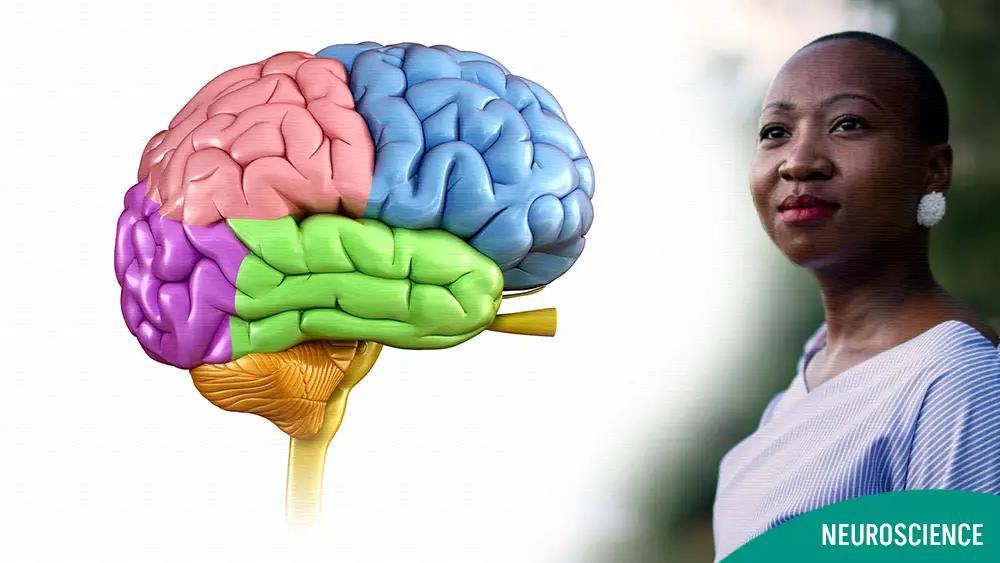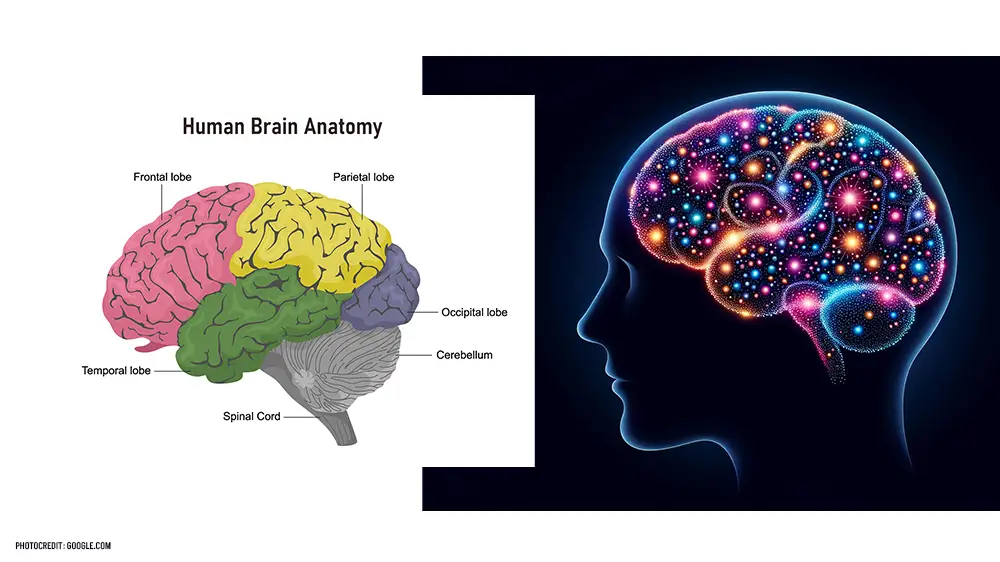
NEUROSCIENCE
The Brain: Unlocking the Secrets of Our Most Complex Organ
-
Rahul Priydarss
Unlock the mysteries of the human brain with this comprehensive article, delving into its structure, functions, development, and health. Explore the intricate anatomy of the brain, from the cerebrum to the brainstem, and learn about its essential roles in sensory processing, motor control, cognition, and emotion regulation. Discover the fascinating world of neurons and synapses, unraveling the mechanisms behind communication within the brain.
Introduction to the Brain:
The brain is the control center of the human body, a marvelously intricate organ that orchestrates and regulates virtually every aspect of our physiology, cognition, and behavior. It is composed of billions of nerve cells called neurons, along with various supporting cells, organized into a complex network that allows for communication and integration of information.
What is the Brain:
The brain is the command center of the human body, an organ of remarkable complexity responsible for regulating and coordinating various physiological processes, cognitive functions, and behaviors. Comprised of billions of neurons and supporting cells, it forms intricate networks that enable communication and integration of information.

Table of Contents
Importance of the Brain in Human Physiology:
The brain plays a pivotal role in human physiology due to its multifaceted functions.
Sensory Processing and Response: The brain receives, interprets, and responds to sensory input from the environment, allowing us to perceive and interact with the world around us effectively.
Regulation of Bodily Functions: Essential physiological processes such as breathing, heartbeat, digestion, and hormone regulation are controlled and coordinated by the brain to maintain internal balance and ensure survival.
Cognition and Consciousness: The brain enables higher-order cognitive functions including learning, memory, reasoning, problem-solving, and decision-making. It also underpins consciousness, shaping our experiences, emotions, and self-awareness.
Motor Control and Coordination: Through complex neural circuits, the brain governs voluntary and involuntary movements, as well as coordination and balance, facilitating interaction with the environment.
Anatomy of the Brain:
The brain is a complex organ that can be divided into several distinct regions, each with its own specialized functions. Understanding the anatomy of the brain is essential for comprehending how it processes information and controls various bodily functions.
Overview of the Brain’s Structure
The brain is situated within the skull and is protected by the cranial bones, meninges (protective membranes), and cerebrospinal fluid. It can be broadly divided into three main parts: the cerebrum, the cerebellum, and the brainstem.
Main Regions of the Brain:
Cerebrum:
- The cerebrum is the largest and most prominent part of the brain, occupying the uppermost portion of the skull.
- It is divided into two hemispheres, each consisting of four lobes: the frontal, parietal, temporal, and occipital lobes.
- The cerebrum is responsible for higher cognitive functions, including conscious thought, perception, memory, and voluntary movement.
- It also houses the cerebral cortex, the outer layer of gray matter that plays a critical role in processing sensory information and generating motor responses.
Cerebellum:
- Located at the back of the brain, beneath the cerebrum, the cerebellum is a smaller structure but crucial for motor coordination and balance.
- It contains densely packed layers of neurons and plays a significant role in fine-tuning movements, maintaining posture, and coordinating motor activities.
Brainstem:
- The brainstem is the lower part of the brain, connecting the cerebrum and cerebellum to the spinal cord.
- It consists of three main structures: the medulla oblongata, the pons, and the midbrain.
- The brainstem regulates essential autonomic functions such as breathing, heart rate, blood pressure, and digestion.
- It also serves as a pathway for nerve fibers traveling between the brain and spinal cord, facilitating communication between different parts of the nervous system.
Functions of the Brain:
The brain is a highly complex organ responsible for a multitude of functions essential for human life and behavior. Below are some of its primary functions.
Sensory Processing: The brain receives and processes sensory information from the environment through various senses such as sight, hearing, touch, taste, and smell. It interprets this information to generate perceptions of the world around us.
Motor Control: The brain coordinates voluntary and involuntary movements of the body, allowing us to walk, talk, eat, and perform various tasks. Motor control involves complex interactions between different regions of the brain and the spinal cord.
Cognition: The brain is central to cognitive processes such as thinking, reasoning, problem-solving, decision-making, and memory formation. These functions are primarily associated with the cerebral cortex, particularly the frontal lobes.
Emotion Regulation: The brain plays a crucial role in experiencing and regulating emotions. Regions such as the limbic system, including the amygdala and hippocampus, are involved in processing emotions and forming emotional responses to stimuli.
Homeostasis: The brain regulates internal balance and stability within the body through the autonomic nervous system. This includes controlling functions such as heart rate, blood pressure, body temperature, and fluid balance.
Consciousness: The brain generates consciousness, allowing us to be aware of ourselves and our surroundings. The exact mechanisms underlying consciousness are still not fully understood but are believed to involve complex interactions between different brain regions.
Language and Communication: Language processing, speech production, and comprehension are facilitated by specialized regions of the brain, such as Broca’s area and Wernicke’s area, located in the cerebral cortex.
Memory Formation and Retrieval: The brain stores and retrieves information through various types of memory, including short-term memory, long-term memory, and procedural memory. The hippocampus and other regions of the temporal lobe play crucial roles in memory processing.
Regulation of Biological Rhythms: The brain controls biological rhythms such as the sleep-wake cycle, circadian rhythms, and hormonal secretion patterns through structures like the hypothalamus and the pineal gland.
Learning and Plasticity: The brain exhibits neuroplasticity, allowing it to adapt and reorganize in response to experiences, learning, and environmental changes. This plasticity underlies the brain’s ability to learn new skills, form memories, and recover from injury.
Basic Unit of the Brain: Neurons:
Neurons are the fundamental units of the brain and nervous system. They are specialized cells that transmit information in the form of electrical and chemical signals. Neurons consist of several key components.
Cell Body (Soma): The cell body contains the nucleus and other organelles essential for the neuron’s metabolic functions.
Dendrites: Dendrites are branching projections that receive signals from other neurons or sensory receptors and transmit them toward the cell body.
Axon: The axon is a long, slender projection that carries electrical impulses, known as action potentials, away from the cell body toward other neurons, muscles, or glands.
Axon Terminals: At the end of the axon, specialized structures called axon terminals release neurotransmitters into the synapse, facilitating communication with neighboring neurons.
How Neurons Communicate Through Synapses:
Neurons communicate with each other through specialized junctions called synapses. The process of communication at synapses involves several steps.
Action Potential: When a neuron receives a signal, typically through its dendrites, it may generate an electrical impulse called an action potential. This action potential travels down the length of the axon toward the axon terminals.
Neurotransmitter Release: When the action potential reaches the axon terminals, it triggers the release of neurotransmitters from synaptic vesicles into the synaptic cleft, a small gap between the axon terminal of one neuron and the dendrite or cell body of another neuron.
Neurotransmitter Binding: Neurotransmitters diffuse across the synaptic cleft and bind to specific receptor molecules on the postsynaptic membrane of the receiving neuron. This binding causes changes in the postsynaptic neuron’s electrical potential.
Postsynaptic Response: Depending on the type of neurotransmitter and the receptors involved, the postsynaptic neuron may become depolarized (excited) or hyperpolarized (inhibited). If the postsynaptic neuron reaches a certain threshold of excitation, it may generate its action potential.
Neurotransmitter Removal: After neurotransmitter binding and postsynaptic response, neurotransmitters are removed from the synaptic cleft through processes such as enzymatic degradation or reuptake by the presynaptic neuron.
Brain Development:
Brain development is a remarkable process that begins early in prenatal life and continues through infancy, childhood, and adolescence into adulthood. It involves intricate changes in the structure and function of the brain, shaping our cognitive abilities, behavior, and overall development.
Developmental Stages from Infancy to Adulthood:
Prenatal Development: Brain development begins in the womb and undergoes rapid growth during prenatal development. Neural progenitor cells divide and differentiate into neurons, forming the basic structure of the brain’s regions and circuits.
Infancy and Early Childhood: After birth, the brain continues to develop rapidly during infancy and early childhood. Neurons form connections, or synapses, at a staggering rate, reaching peak synaptic density around age two. This period is critical for sensory and motor development, language acquisition, and the establishment of basic cognitive skills.
Childhood and Adolescence: Throughout childhood and adolescence, the brain undergoes significant refinement and reorganization. Synaptic pruning, a process in which weak or unnecessary connections are eliminated while stronger connections are strengthened, occurs during this time, shaping the brain’s neural circuits and optimizing its efficiency.
Adulthood: While brain development continues into adulthood, it occurs at a slower pace compared to earlier stages. Certain brain regions, such as the prefrontal cortex responsible for higher-order cognitive functions like decision-making and impulse control, may continue to mature well into the mid-20s or later.
Factors Influencing Brain Development:
Genetics: Genetic factors play a significant role in shaping brain development, influencing aspects such as neuronal structure, neurotransmitter function, and susceptibility to neurological disorders.
Early Environment: The quality of early experiences, including prenatal care, nutrition, exposure to toxins, and caregiving practices, profoundly impacts brain development. Positive early experiences, such as responsive caregiving and enriched environments, promote healthy brain development, while adverse experiences, such as neglect or trauma, can disrupt it.
Stimulation and Enrichment: Exposure to a stimulating and enriching environment, including opportunities for sensory exploration, social interaction, and cognitive stimulation, supports the formation of robust neural connections and promotes cognitive development.
Nutrition: Adequate nutrition, particularly during critical periods of brain development, is essential for providing the energy and nutrients necessary for neuronal growth, myelination (the process of insulating neurons with a fatty sheath), and synaptic plasticity.
Stress: Prolonged or excessive stress during early development can have detrimental effects on brain development, impairing neuronal connectivity, altering stress response systems, and increasing vulnerability to mental health disorders later in life.
Sleep: Sleep plays a crucial role in brain development, facilitating synaptic pruning, memory consolidation, and neural plasticity. Adequate sleep is especially important during infancy and childhood when the brain is most active and malleable.
Brain Health and Maintenance:
Maintaining brain health is crucial for overall well-being and cognitive function throughout life. Several factors contribute to brain health and can help prevent cognitive decline and neurodegenerative diseases.
Importance of Nutrition for Brain Health:
Proper nutrition plays a vital role in supporting brain health. Certain nutrients are essential for brain function and can help protect against cognitive decline. Some key nutrients include.
Omega-3 Fatty Acids: Found in fatty fish like salmon, walnuts, and flaxseeds, omega-3 fatty acids are critical for brain health, supporting neuronal structure and function.
Antioxidants: Foods rich in antioxidants, such as berries, dark chocolate, and leafy greens, help protect brain cells from oxidative stress and inflammation, which can contribute to cognitive decline.
Vitamins and Minerals: B vitamins (particularly B6, B12, and folate), vitamin E, and minerals like zinc and magnesium are important for various aspects of brain function, including neurotransmitter synthesis and energy metabolism.
Healthy Fats: Incorporating sources of healthy fats, such as avocados, olive oil, and nuts, into your diet can support brain health and cognitive function.
Hydration: Staying hydrated is essential for optimal brain function. Dehydration can impair cognitive performance and mood, so it’s important to drink plenty of water throughout the day.
Mental Exercises and Activities for Brain Maintenance:
Engaging in mentally stimulating activities can help maintain cognitive function and promote brain health.
Brain Games: Activities like puzzles, crosswords, Sudoku, and brain-training apps can help challenge your cognitive abilities and keep your brain sharp.
Learning New Skills: Learning new skills or hobbies, such as playing a musical instrument, learning a new language, or taking up a new sport, can stimulate brain activity and promote neuroplasticity.
Reading: Reading books, articles, or engaging in other forms of literature stimulates the brain, improves vocabulary, and enhances cognitive function.
Socializing: Social interaction is important for brain health, as it can help reduce stress, boost mood, and stimulate cognitive function. Stay connected with friends and family through regular social activities.
Physical Exercise: Regular physical exercise not only benefits physical health but also supports brain health. Exercise increases blood flow to the brain, promotes the release of neurotrophic factors, and enhances cognitive function.
Mindfulness and Meditation: Practicing mindfulness and meditation techniques can help reduce stress, improve attention and focus, and promote overall brain health.

Common Brain Disorders:
The brain is a complex organ, and various disorders can affect its structure and function, leading to a range of neurological and psychiatric conditions. Some of the most common brain disorders include.
Alzheimer’s Disease: Alzheimer’s disease is a progressive neurodegenerative disorder characterized by memory loss, cognitive decline, and behavioral changes. It is the most common cause of dementia in older adults.
Parkinson’s Disease: Parkinson’s disease is a neurodegenerative disorder that primarily affects movement. It is characterized by symptoms such as tremors, bradykinesia (slowed movement), muscle stiffness, and impaired balance and coordination.
Stroke: Stroke occurs when blood flow to the brain is interrupted, either due to a blockage (ischemic stroke) or bleeding (hemorrhagic stroke). It can result in sudden weakness or paralysis, difficulty speaking or understanding language, and cognitive impairments.
Epilepsy: Epilepsy is a neurological disorder characterized by recurrent seizures, which are sudden, uncontrolled electrical disturbances in the brain. Seizure types and severity can vary widely among individuals.
Multiple Sclerosis (MS): Multiple sclerosis is an autoimmune disorder that affects the central nervous system, including the brain and spinal cord. It can cause a wide range of symptoms, including fatigue, muscle weakness, numbness or tingling, and difficulty with coordination and balance.
Migraine: Migraine is a neurological disorder characterized by recurrent episodes of severe headache, often accompanied by other symptoms such as nausea, vomiting, and sensitivity to light and sound.
Depression: Depression is a mood disorder that affects how a person feels, thinks, and handles daily activities. It is characterized by persistent feelings of sadness, hopelessness, and loss of interest or pleasure in activities.
Anxiety Disorders: Anxiety disorders are a group of mental health conditions characterized by excessive worry, fear, or apprehension. Common types include generalized anxiety disorder, panic disorder, social anxiety disorder, and phobias.
Traumatic Brain Injury (TBI): TBI occurs when a sudden trauma, such as a blow or jolt to the head, causes damage to the brain. Symptoms can range from mild, such as headache and confusion, to severe, including loss of consciousness and cognitive impairment.
Schizophrenia: Schizophrenia is a chronic and severe mental disorder that affects how a person thinks, feels, and behaves. It is characterized by hallucinations, delusions, disorganized thinking, and impaired social functioning.
Brain and Memory:
Memory is a fundamental aspect of human cognition, allowing us to store and retrieve information about past experiences, facts, and skills. The brain plays a central role in the formation, storage, and retrieval of memories through intricate neural processes.
Different Types of Memory:
Short-Term Memory: Short-term memory, also known as working memory, holds information temporarily for immediate use. It has limited capacity and duration and is involved in tasks such as remembering a phone number or following instructions.
Long-Term Memory: Long-term memory involves the storage of information over extended periods, ranging from minutes to years or even a lifetime. It can be further categorized into two main types.
A. Explicit (Declarative) Memory: Explicit memory involves the conscious recall of facts, events, and experiences. It includes:
- Episodic Memory: Records personal experiences and events, such as specific moments from one’s past.
- Semantic Memory: Stores general knowledge and factual information, such as language, concepts, and meanings.
B. Implicit (Non-declarative) Memory: Implicit memory refers to unconscious or automatic memory processes that influence behavior without conscious awareness. It includes procedural memory, such as motor skills, habits, and conditioned responses.
How Memories Are Formed and Stored in the Brain:
Encoding: Memory formation begins with encoding, where sensory information is processed and transformed into a neural code that can be stored. Different sensory modalities activate specific brain regions associated with encoding.
Consolidation: Once encoded, memories undergo consolidation, a process where they are stabilized and strengthened for long-term storage. This process involves the reactivation and strengthening of synaptic connections between neurons, particularly in regions like the hippocampus.
Storage: Memories are stored in various brain regions depending on their type. For example, episodic memories are associated with the hippocampus and surrounding structures, while semantic memories are distributed across cortical regions.
Retrieval: Retrieval is the process of accessing stored memories when needed. It involves reactivating the neural patterns associated with the encoded information and bringing it into conscious awareness. Retrieval cues can facilitate memory recall.
Reconsolidation: Memories are not static but can be modified through reconsolidation. When retrieved, memories become temporarily labile and susceptible to modification before being reconsolidated.
The Brain and Emotions:
The brain plays a central role in processing emotions, regulating mood, and shaping our emotional experiences. Understanding the brain’s involvement in emotions is essential for comprehending human behavior and mental health.
Role of the Brain in Processing Emotions:
Limbic System: The limbic system, a network of brain structures including the amygdala, hippocampus, and hypothalamus, plays a crucial role in processing emotions. The amygdala, in particular, is involved in detecting and responding to emotional stimuli, such as fear and pleasure, and plays a key role in emotional memory formation.
Prefrontal Cortex: The prefrontal cortex, especially the ventromedial prefrontal cortex (vmPFC) and orbitofrontal cortex (OFC), regulates and modulates emotional responses. It is involved in decision-making, impulse control, and evaluating the emotional significance of stimuli.
Neurotransmitters: Neurotransmitters such as serotonin, dopamine, and norepinephrine play important roles in regulating mood and emotion. Imbalances in these neurotransmitter systems can contribute to mood disorders such as depression and anxiety.
Neural Circuits: Complex neural circuits connect various brain regions involved in emotion processing, allowing for the integration and regulation of emotional responses. These circuits mediate interactions between cognitive processes, sensory input, and emotional experiences.
Connection between Brain Health and Emotional Well-being:
Neuroplasticity: The brain exhibits neuroplasticity, the ability to reorganize and adapt in response to experiences and environmental influences. Positive experiences, such as engaging in activities that promote emotional well-being, can foster neuroplasticity and support brain health.
Stress Response: Chronic stress can negatively impact brain health and emotional well-being by dysregulating the hypothalamic-pituitary-adrenal (HPA) axis and increasing levels of stress hormones like cortisol. Prolonged stress can lead to structural changes in the brain, particularly in regions involved in emotion regulation.
Physical Health: Brain health and emotional well-being are interconnected with physical health. Factors such as exercise, nutrition, sleep, and overall lifestyle habits can influence brain function and emotional resilience.
Mental Health Disorders: Disorders such as depression, anxiety, and post-traumatic stress disorder (PTSD) are associated with alterations in brain structure and function, including abnormalities in emotion processing circuits. Addressing these disorders through therapy, medication, and lifestyle interventions can improve emotional well-being and support brain health.
Social Connection: Social support and interpersonal relationships play a significant role in emotional well-being and brain health. Positive social interactions can buffer against the negative effects of stress and promote emotional resilience.
Brain and Sleep:
Sleep is a vital process that plays a crucial role in maintaining brain function and overall health. The brain regulates sleep cycles through complex mechanisms involving various brain regions, neurotransmitters, and hormones.
Importance of Sleep for Brain Function:
Memory Consolidation: During sleep, the brain consolidates and integrates new information and experiences into long-term memory. This process, known as memory consolidation, is essential for learning, problem-solving, and cognitive function.
Brain Plasticity: Sleep promotes brain plasticity, the brain’s ability to reorganize and adapt in response to experiences. It allows for the strengthening of synaptic connections and the removal of unnecessary or redundant connections, optimizing brain function.
Emotional Regulation: Adequate sleep is crucial for emotional regulation and resilience. Sleep deprivation can impair mood regulation, increase susceptibility to stress, and exacerbate symptoms of mood disorders such as depression and anxiety.
Neurotransmitter Balance: Sleep helps maintain a balance of neurotransmitters in the brain, including serotonin, dopamine, and norepinephrine, which are important for mood regulation, cognition, and emotional well-being.
Restoration and Repair: Sleep is a period of restorative rest during which the brain undergoes processes of repair and detoxification. It allows for the removal of metabolic waste products and toxins that accumulate during waking hours, supporting overall brain health.
How the Brain Regulates Sleep Cycles:
The Sleep-Wake Cycle: The sleep-wake cycle is regulated by a complex interplay between brain regions involved in arousal and sleep. The suprachiasmatic nucleus (SCN) of the hypothalamus serves as the brain’s internal clock, synchronizing sleep-wake rhythms with the light-dark cycle.
Neurotransmitters: Several neurotransmitters play key roles in regulating sleep-wake cycles. These include:
- Adenosine: Adenosine accumulates in the brain during wakefulness and promotes sleep by inhibiting arousal-promoting neurotransmitters.
- GABA (Gamma-Aminobutyric Acid): GABA is an inhibitory neurotransmitter that promotes sleep by reducing neuronal activity and inducing relaxation.
- Serotonin: Serotonin levels fluctuate across the sleep-wake cycle and play a role in regulating sleep onset and maintenance.
- Melatonin: Melatonin, produced by the pineal gland, is involved in regulating the sleep-wake cycle and promoting sleep onset, particularly in response to darkness.
Sleep Stages: Sleep is divided into distinct stages, including non-rapid eye movement (NREM) sleep and rapid eye movement (REM) sleep. These stages are characterized by different patterns of brain activity, neuronal firing, and physiological changes.
Hypothalamic Regulation: The hypothalamus plays a central role in regulating sleep by integrating signals from various brain regions and coordinating physiological processes such as body temperature, hormone secretion, and sleep-wake transitions.
Brain or Neuroscience Research:
Brain research, also known as neuroscience, is a rapidly evolving field that seeks to understand the structure and function of the human brain. Here’s a glimpse into some of the exciting trends and technological advancements propelling this field forward.
Current Trends in Neuroscience Research:
1- Mapping the Connectome: One of the major thrusts in neuroscience is creating a detailed map of all the connections within the brain, known as the connectome. This intricate wiring diagram is crucial to understanding how different brain regions communicate with each other, giving rise to complex functions like thought, emotion, and movement.
2- Understanding the Microbiome-Brain Connection: The trillions of microbes residing in our gut, known as the gut microbiome, are increasingly being recognized for their influence on brain health. Research suggests that the gut microbiome can communicate with the brain via the vagus nerve, impacting mood, cognition, and even neurodegenerative diseases.
3- The Rise of Neurotechnologies: Technological innovations are playing a pivotal role in neuroscience research. Tools like optogenetics, which uses light to control specific neurons and deep brain stimulation (DBS), which delivers electrical impulses to targeted brain regions, are offering unprecedented insights into brain function and paving the way for new therapeutic approaches for neurological and psychiatric disorders.
4- Focus on Neuroinflammation: Chronic inflammation in the brain is now being implicated in various neurological disorders, including Alzheimer’s disease, Parkinson’s disease, and multiple sclerosis. Understanding the mechanisms of neuroinflammation and developing methods to control it is a major area of research interest.
5- Precision Psychiatry: The field of psychiatry is moving towards a more personalized approach that takes into account individual differences in brain function and genetics. This approach, known as precision psychiatry, aims to develop targeted treatments for mental health conditions based on a patient’s specific biological profile.
Technological Advancements in Studying the Brain:
1- Brain Imaging Techniques: Advancements in brain imaging techniques like functional magnetic resonance imaging (fMRI) and magnetoencephalography (MEG) are allowing researchers to visualize brain activity with ever-increasing resolution and detail. This enables them to pinpoint the specific brain regions involved in various cognitive processes and neurological disorders.
2- Artificial Intelligence (AI) and Machine Learning: AI and machine learning algorithms are being harnessed to analyze vast amounts of brain imaging data, identify subtle patterns, and accelerate our understanding of brain function in health and disease.
3- Brain Organoids: These 3D laboratory-grown structures, comprised of human stem cells, are being developed to mimic the structure and function of certain brain regions. Brain organoids offer a powerful tool to study brain development, disease processes, and potential treatments for neurological conditions.
4- Genetic Engineering Techniques: Techniques like CRISPR-Cas9 are being used to manipulate genes in brain cells to understand their role in brain function and behavior. This holds immense promise for developing gene therapies for neurological disorders with a genetic component.
Challenges in Understanding the Brain:
The human brain is undoubtedly the most complex organ in our body. Despite significant advancements, neuroscientists still face hurdles in fully understanding this intricate structure. Here’s a breakdown of the challenges.
Complexity of the Human Brain:
1- Sheer Number of Components: The brain is estimated to contain roughly 86 billion neurons, each connected to thousands of others through trillions of synapses. These connections constantly change and adapt throughout our lives, making it a dynamic and ever-evolving system.
2- Multi-Scale Organization: The brain operates on multiple levels, from the intricate interactions between individual neurons to the complex communication between different brain regions. Understanding how these levels work together to produce consciousness, thought, and behavior is a major challenge.
3- The Messy Mind: Unlike a computer with its clean code, the brain is messy. There’s redundancy and variability in its structure and function. This makes it difficult to isolate the specific causes of behavior and brain disorders.
Limitations in Current Knowledge and Research:
1- Limited Tools for Studying Live Brains: Many neuroscience techniques require invasive procedures, limiting our ability to study the brain in its natural, functioning state. Furthermore, ethical considerations restrict research on the healthy human brain.
2- Challenges in Data Analysis: Neuroscience research generates massive amounts of data from imaging techniques. Analyzing and interpreting this complex data to extract meaningful insights remains a significant challenge.
3- The Mind-Body Problem: A fundamental question is how physical processes in the brain give rise to subjective experiences like consciousness and emotions. Bridging the gap between the physical and the mental remains a philosophical and scientific hurdle.
4- Lack of Comprehensive Models: Currently, we lack a unified model that explains how all the different components of the brain work together to produce complex functions. Developing such a model would be a breakthrough in neuroscience.
FAQs about Brain and Neuroscience:
A1: The brain serves as the command center, regulating physiology, cognition, and behavior, orchestrating virtually every aspect of our functioning.
A2: Through billions of neurons and intricate networks, the brain receives, integrates, and responds to sensory input, allowing us to perceive and interact with the world.
A3: Brain health is crucial for overall well-being, influencing cognition, emotion regulation, and physical functions like sleep and appetite.
A4: Brain disorders like Alzheimer’s, Parkinson’s, epilepsy, and depression can impair cognitive function, motor control, and emotional well-being, affecting quality of life.
A5: Activities like regular exercise, healthy eating, mental stimulation, social engagement, and sufficient sleep support brain health and cognitive function throughout life.
-Please remember, to always consult with healthcare professionals or Doctors for personalized advice related to medical conditions.
Conclusion:
Our brain, the control center of our body, is a complex marvel. From processing sensory information to regulating emotions and storing memories, it orchestrates everything that makes us human. Scientists are constantly unraveling its mysteries, exploring how its structure and function influence our health, behavior, and even the future of medicine.




